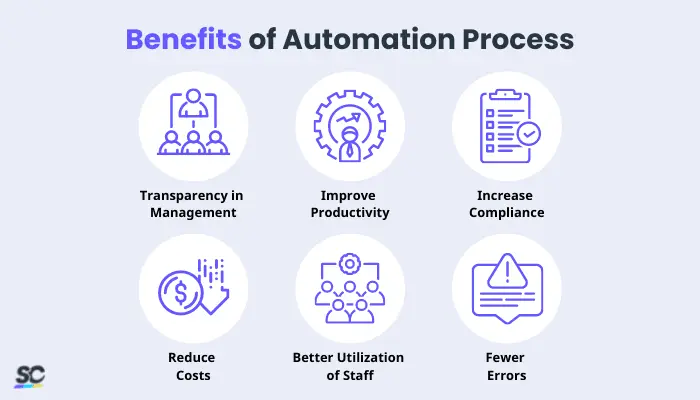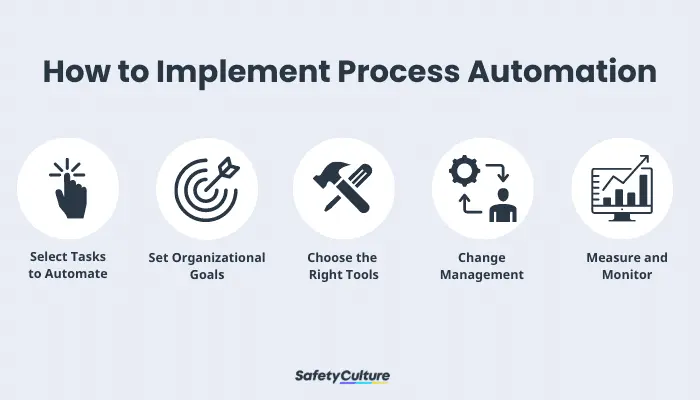What is the Automation Process?
Automation process refers to using technology to complete a task that a human would otherwise complete. Automation can streamline operations and improve efficiency by completing tasks faster and with fewer errors.
Simpler processes may be easier to adjust and simpler to understand. But by automating them, you may be able to speed up the process and make it more consistent. Quality and compliance may also improve.
By comparison, advanced process automation systems include many features that make them considerably more complex. They automate various business processes to make the company’s operations more efficient and effective. It usually consists of three functions: automating procedures, consolidating data, and minimizing human input requirements.
Business Process Automation Examples
Here are a few use cases to help you grasp business process automation in greater depth.
Employee Onboarding
Hiring staff indeed appears to be a simple procedure. However, it entails numerous activities. Filling out personnel information forms, arranging induction sessions, scheduling training sessions, establishing bank accounts, obtaining necessary papers, and assigning mentors are just a few of the aspects involved.
The following are some of the key benefits of using an automation tool to grow your business:
- Tedious paperwork
- Skipping out on some tasks
- Employee dissatisfaction is high
- Low output
Applying an automation process to employee onboarding ensures smooth transitions from one step to the next, keeping relevant employees informed and allowing managers insight into the progress of the process.
Purchase Orders (POs)
In most businesses, purchase order requests are systematic procedures. The requesting team submits a form to the purchasing department. The issuing authority reviews the request and either approves or rejects it if the information is insufficient or there are financial constraints. In turn, the requesting team receives the document. Upon approval, the supply team and inventory team receive a purchase order.
The following difficulties may develop without automation:
- A delay occurs in approving the PO
- Inefficiency hinders productivity
- Incomplete records
- Problems with the PO
- Errors that may appear while receiving the goods
An automation process may assist businesses in improving accountability and transparency, as well as accurate data recording that can be viewed by relevant stakeholders when necessary. It will also keep all process-related communication within the workflow to make implementation easier and more efficient.
Process Automation vs. Robotic Process Automation
Some people think of these two words as synonymous. There are, however, some critical distinctions between Robotic Process Automation (RPA) and process automation. When it comes to automating business processes, they’re similar; but that’s where their similarities end.
The most typical form of process automation is much broader in scope and nature. It involves utilizing machinery to execute operations, computer software, data storage systems, and integration activities. On the other hand, robotic process automation is concerned with front-end activities and approximates work similarly to a person.
While process automation requires significant IT and development input, robotic process automation relies on self-learning robots. RPA usually handles basic IT activities such as email replies, data extraction, and other routine system functions.
Many of the tasks included in an enterprise process include the following:
- Gathering data files and tracking activities
- Automating manual processes
- Interfacing with and combining data sources and services
When Would an Organization Use Process Automation?
Automated processes include invoicing, sales orders, accounting reconciliation, data entry, system queries, payroll, employee or vendor onboarding, and staff termination. A service firm is an excellent example of when process automation might be helpful. They may begin by examining their current processes for blockages, errors, or omissions. Let’s say, for example, that a refrigeration service company wanted to automate its service sheet process:
- A customer calls. Working systems record details and create jobs manually.
- After returning to base, the engineer approves the code and receives a physical piece of paper.
- The engineer goes to the job and records on the worksheet all of the parts utilized, how long it took, how far they got, and any additional pertinent data.
- The engineer departs for the day at the end of his shift. They return to the workplace the next day, where they turn in their paperwork.
- The admin staff manually gathers files, modifies the system, orders parts as needed, and bills mileage and consumables.
- The invoice is generated upon completion of the task and sent to the client. This process can continue if parts are on order or the work requires a lot of labor.
In that system, there are numerous opportunities for information to be lost, schedules missed, paperwork left on site, and so on. Process automation eliminates all of the potentials for variation and difficulties.
Engineers can now enter and acquire data electronically thanks to the incorporation of hardware such as smartphones. Actual mileage may be taken from the daily use using fleet monitoring systems, which automatically apply it to the task.
The role of software is crucial. For example, the engineer who enters what components they used may trigger an automatic warning to order more sensors, a type of cable, or even a direct email to the supplier. The system automatically generates and approves purchase orders without requiring manual approval. Upon completion, the system enters all the information automatically, saving time and preventing human errors.
Process automation can occur in any sector and operation with multiple stages. Consider business processes that are cyclical and prone to delays, such as loan processing and approvals, customer service, and approval management.
Benefits of Automation Process
Process automation, with a bespoke, holistic approach like process design, should provide several advantages for any business that employs it correctly.

Transparency in Management
The day-to-day operations may soon become all management cares about; management details may bury the company’s overall plan. Owners can clearly understand their business and its functions by sitting down, going through process workflows, and implementing the automation process. Established procedures provide deeper insight into the company and the potential for future growth.
Improve Productivity
Business process automation is still the key to increasing productivity in businesses. Automation removes bottlenecks and eliminates time-consuming manual operations, growing organizations’ productivity.
Increase Compliance
System automation improves compliance and conformity, whether inside or outside an organization’s policy and standards. Processes are not the same as other things. There are no corners cut, no steps missed, or steps forgotten in a process because everything happens automatically. An automation process should be an essential part of everyday operations for any company with governance, risk, or compliance issues.
An automated process is also an ideal part of everyday operations for any company looking to improve project planning and execution consistency for a more efficient process approach.
Reduce Costs
The most notable advantages of process automation are its cost-cutting potential. When processes are automated, there is no longer a need to hire as many staff.
Automation can take over most repetitive tasks that human employees would otherwise complete. With process automation, businesses can also enjoy reduced facilities costs and other associated expenses.
Better Utilization of Staff
It is more efficient for employees to work in vital parts of the business. They will be happier and more satisfied as a result of this, resulting in improved company outcomes.
Fewer Errors
When errors occur, they may cause concern and create difficulties for a business. While resolving minor mistakes or an incorrect address is typical, it consumes time unnecessarily. In the long run, such issues could damage the company’s bottom line, customer satisfaction, and labor costs. Automation eliminates a lot of room for mistakes.
Digitize the way you Work
Empower your team with SafetyCulture to perform checks, train staff, report issues, and automate tasks with our digital platform.
Get Started for FreeChallenges and Solutions in Automating Processes
Automation, like any other process or software, has its issues. This section explores the potential challenges arising from the automation process.
Difficult to Scale
Several factors contribute to this issue’s complexity:
- Employees’ resistance to adopting automation processes
- Limitations of tools (for example, inability to handle unstructured data)
- Variations to procedures or unusual complexity are common
- Management’s lack of strategic direction
- Interfaces are changing, or automation is breaking down
Solution: It is possible to resolve any issues by doing the research phase correctly and ensuring staff approval. However, with business and software’s dynamic nature, the system must be checked for faults regularly and improved as necessary.
Software testing is crucial to ensure that no breakdowns in procedures occur. Moreover, it’s vital that senior IT or management should be present regularly to maintain processes in place or advise when improvements or adjustments are required.
Errors in Implementation
Process automation begins with identifying all phases of the process. The next step is to identify all processes and determine which ones are manual and can be automated.
Solution: Each phase of the development process must consider every tiny detail. There is no room for speculation or assumptions; the procedure must be extensive.
Trying to Implement Everything at Once
It’s not possible to undertake a comprehensive system change all at once. Staff training must happen simultaneously, and employee resistance is likely.
Solution: One process at a time should be automated. It might even be a tiny aspect of the procedure. For example, if an organization updates its accounts payable procedure, consider automating statements before moving on to debt collection. It also enables tiny, continuous adjustments, improved training, and more possibilities for success.
If simple activities are effective, more complicated business processes and dynamic solutions are more likely to succeed.
No Goal Management
Many projects fail to establish goals and Key Performance Indicators (KPI) at the beginning. After the system is in place, maintaining those procedures and achieving goals becomes a challenge. However, when processes are no longer automated, this is when things go wrong. A worker determines that a step has been overlooked and decides to complete each activity daily manually. Alternatively, the procedure becomes so sluggish that the two-day goal slides and turns into a five-day process.
Solutions: The system will require ongoing monitoring and management. Once put in place, the system may need to be altered or modified; it is essential to embrace change.
How to Implement Process Automation
The five fundamental phases may vary from one business to the next, but they all follow a similar path.

Find Out Which Tasks and Processes Can Be Automated
Automating every task is not a viable option. Technology, however, has made it possible to automate some processes readily. Consider activities that occur at an organizational level:
- Repetitive activities
- Time-sensitive activities
- Procedures that include a variety of individuals and objects
- Compliance trails or auditing required
- Processes that influence other business processes and systems
- Rule-based and standardization efforts
- Initiatives with a lot of potential for a high return on investment
- Process maps to show the current system
Set Your Organizational Goals
Any change won’t lead to meaningful improvements unless you have a clear goal. Identifying the company’s objectives and how automation can assist in achieving them is the first step. Decide the measurement of success as well, such as the following metrics:
- Fewer customer complaints
- A quicker turn-around time
- Increased profitability
Deciding becomes easier by weighing each option against where it will lead you to your objectives.
Choose the Right Tools
To discover the right answers, you must first conduct research. It might help to seek the input of specialists who have created successful process automation systems.
The ideal solution should be simple to operate with simple and easy-to-use interfaces and high usability. It should be flexible, adaptable, and scalable enough to accommodate future expansion and change in the company. It should also interact with other applications and tools and have a data processing method.
Change Management
Change management is, in many ways, the most crucial stage of adopting new automation. Getting staff’s buy-in and training them on the software’s use helps to ensure it is used correctly and with a good attitude.
Incorporating the team into the planning process, establishing an open feedback loop that includes both sides, and providing continued education all aid in making a smooth transition to the new process.
Measurement and Monitoring
Your new approach and tools will not be static. As the company’s demands change, so should the system.
Continually monitor KPIs to determine whether they’re accurate. If performance dips, evaluate the process and reconsider critical elements that are necessary to system longevity.




